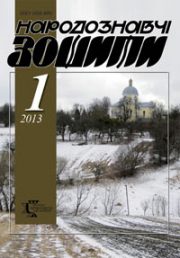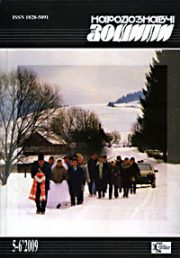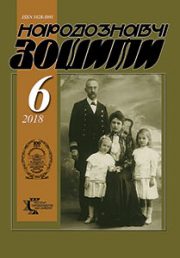The Ethnology Notebooks. 2024. № 1 (175), 211—219
UDK [821.161.2-13/-14.09:398.87]:001.891М.Возняк
DOI https://doi.org/10.15407/nz2024.01.211
ACADEMICIAN MYKHAILO VOZNIAK AS A RESEARCHER OF DUMAS
SHUMEIKO Oksana
- ORCID ID: https://orcid.org/0000-0001-6706-6440
- Graduate student, Ivan Franko National University,
- Department of Ukrainian folkloristics
- named after Academician Filaret Kolessa,
- 1, University St., 79000, Lviv, Ukraine,
- Contacts: e-mail: oksankakobasar@gmail.com
Abstract. The article analyzes the works of Mykhailo Vozniak, which touch upon the duma tradition, and highlights the scientist’s contribution to Ukrainian duma studies. The scholar’s views on the nature of the duma genre are clarified.
One of those who studied it and whose research has not been sufficiently highlighted in science is Academician Mykhailo Stepanovych Vozniak. The scientist first discovered the unique manuscript «Kondratskyi Collection», from which he singled out several dumas, which gave impetus to further research into the specifics of works in this genre. It is thanks to him that the oldest record of the duma about a lazy Cossack (1684) has been preserved to this day.
The purpose of the study is to evaluate the contribution of the literary historian and folklorist M. Vozniak to the study of folk dumas. The object of research is dumas, and the subject is the peculiarities of their analysis in the scientific heritage of this scientist. The task of the article is to consider Mykhailo Vozniak’s research on dumas, in particular, to clarify their definition and place in the genre palette of Ukrainian folklore, as well as his analysis of duma texts.
Since Mykhailo Vozniak’s scientific activity in the field of folklore has not been well enough highlighted, there is a need to study one of the interests of the academician — a thorough and comprehensive study of the original genre of Ukrainian oral literature — dumas. This is where the relevance of the article lies.
The focus is on the position of the scientist that dumas are exclusively a Ukrainian genre of oral literature, which he attributed to epic poetry. It is emphasized that during a detailed study of the duma about a lazy Cossack (in later versions, «lazy» was replaced with «Golota»), the academician proved that over time it varied, and the closest text to it was the recording of P. Kulish from Arkhyp Nikonenko. It is important that the scientist attempted to reconstruct the text of the folk work «Oh, the river Styr, which Hmili made against faith», which in its original version sounds like «Duma kozackaia o wojni s kozacamy nad rikoju Styru». It is emphasized that although the academician did not offer his own classification of dumas, he considered them in the context of literature (the section «Historical Song and Cossack Epic» in the «History of Ukrainian Literature»). Mykhailo Vozniak was also concerned about the existence of the genre, claiming that it was unfortunately actively dying out due to the political circumstances of the time.
The methodological basis of the article consists of bibliographic and descriptive methods.
Keywords: Mykhailo Vozniak, «Kondratskyi Collection», «History of Ukrainian Literature», duma, lazy Cossack, Cossack epic.
Received 15.12.2023
REFERENCES
- Sreznevsky, I. (1834—1838). Antiquity of Zaporizhzhya. Kharkiv: Univ. typography [in Ukrainian].
- Kostomarov, N. (1843). On the historical meaning of Russian folk poetry. Kharkiv: Printing House of the University Press [in Russian].
- Maksimovich, M.A. (1834). Ukrainian national dumas. Moskva: Univ. Printing house (Books 1—3) [in Russian].
- (1834). Ukrainian folk songs published by Mykhailo Maksymovych (Part 1, book 1—3: Ukrainian Dumas. Cossack songs from the past. Cossack everyday songs). Moskva: In the University Printing House [in Ukrainian].
- Kulish, P., & Ivashkiv, V. (Ed.). (2015). Complete works. Scientific works. Publicistics (Vol. 3, book 1). Kyiv: Krytyka [in Ukrainian].
- (1874). Historical songs of the Malorussian people with explanations by V. Antonovych and M. Drahomanov (Vol. 1). Kyiv: Typ. M.P. Fritz [in Ukrainian].
- Hrushevska, K. (1929). On the side paths of the kobzar epic. Primal citizenship, 2, 13—50 [in Ukrainian].
- Hrushevska, K. (1927). Ukrainian folk dumas. Kyiv: State Publishing House of Ukraine (Vol. 1, texts 1—13) [in Ukrainian].
- Hrushevska, K. (1931). Ukrainian folk dumas (Vol. 2). Kyiv; Kharkiv: Proletar [in Ukrainian].
- Kolessa, F. (1920). Ukrainian folk dumas: the first complete edition with research, explanations, notes and pictures of kobzars. Lviv: Prosvita Publishing House [in Ukrainian].
- Betsenko, T. (2013). The question of the origin of the genre and language of folk dumas (research summary). Ridnyj kraj, 1, 53—59 [in Ukrainian].
- Nudha, H. (1961). Parody in Ukrainian literature. Kyiv [in Ukrainian].
- Nudha, H. (1997, 1998). Ukrainian Duma and Songin the World: in 2 books. (Book 1, 2). Lviv: Institute of Ethnology of the National Academy of Sciences of Ukraine [in Ukrainian].
- Plisetskyi, M. (1994). Ukrainian folk dumas: the mesandimages. Kyiv: Kobza [in Ukrainian].
- Hrytsa, S. (1995). Ukrainian Dumas in Interethnic Dialogue. Ancestry, 11, 68—81 [in Ukrainian].
- Myshanych, S. (2003). Ukrainian folk dumas. Folklore and literary studies: in 2 vols. (Vol. 2, pp. 398—414). Donetsk: Donetsk National University [in Ukrainian].
- Myshanych, S. (2003). The principles of scientific publication of the complete collection of Ukrainian national dumas. Problems of textology. Folklore and literary studies: in 2 vols. (Vol. 1, pp. 110—142). Donetsk: Donetsk National University [in Ukrainian].
- Pylypchuk, S. (2011). Ivan Franko’s Duma studies. Ukrainian literary studies, 74, 215—225 [in Ukrainian].
- Harasym, Y. (2001). Ivan Franko as a researcher of duma. Ukrainian literary studies, 64, 103—110 [in Ukrainian].
- Vozniak, M. (1924). History of Ukrainian literature (Vol. 3, part 2). Lviv: Prosvita [in Ukrainian].
- Vozniak, M. (1922). Old Ukrainian literature. Lviv [in Ukrainian].
- Voznyak, M. (1928). Duma about a Cossack-pauper in the record of the late XVII century. Collection of the historical and philological department of the Ukrainian Academy of Sciences, 76 b [in Ukrainian].
- Kirdan, B. (1962). Ukrainian national dumas. Мoskva [in Russian].
- Nabok, M. (2010). Ukrainian folk dumas: typology of the hero andfeatures of the national character: PhD thesis. Lviv [in Ukrainian].
- Kamanin, I. (1913). Ukrainian bogatyrs of the Cossack era. Notes of the Ukrainian Scientific Society in Kyiv (Book 11, pp. 53—74) [in Ukrainian].
- (1849). Collection of Ukrainian songs published by Mykhailo Maksymovych. Kyiv: in the Type. Theophilus Glucksberg [in Ukrainian].







